Renault Trucks found a singularly appropriate way to publicise its
Page 46
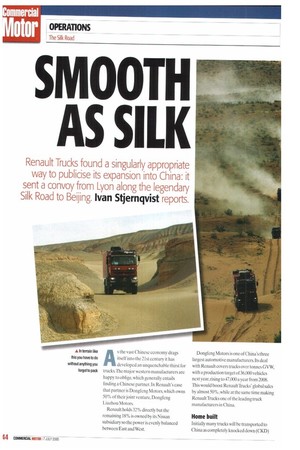
Page 47
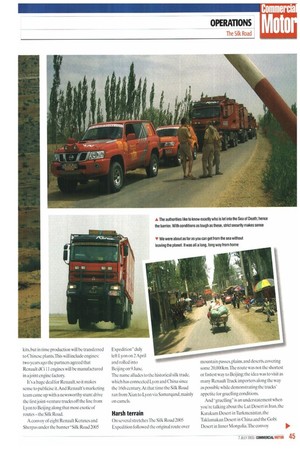
Page 48
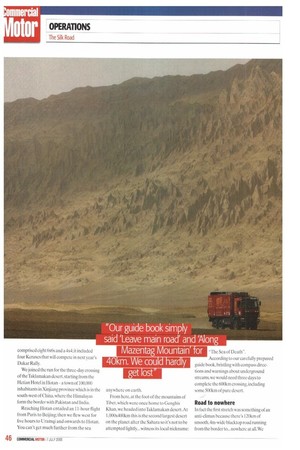
Page 53
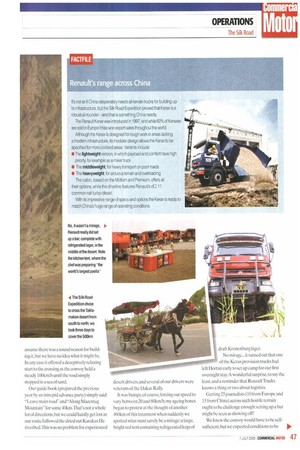
Page 54
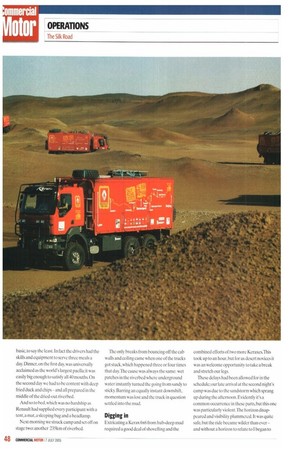
Page 55

If you've noticed an error in this article please click here to report it so we can fix it.
expansion into China: it sent a convoy from Lyon along the legendary Silk Road to Beijing. Ivan Stjernqvist reports.
As the vast Chinese economy drags itself into the 21st century it has developed an unquenchable thirst for trucks.The major western manufacturers are happy to oblige, which generally entails finding a Chinese partner. In Renault's case that partner is Dongfeng Motors, which owns 50% of their joint venture, Dongfeng Liuzhou Motors.
Renault holds 32% directly but the remaining 18% is owned by its Nissan subsidiary so the power is evenly balanced between East and West. Dongfeng Motors is one of China's three largest automotive manufacturers. Its deal with Renault covers trucks over tonnes GVW, with a production target of 36,000 vehicles next year, rising to 47,000 a year from 2008. This would boost Renault Trucks' global sales by almost 50%, while at the same time making Renault 'Rucks one of the leading truck manufacturers in China.
Home built
Initially many trucks will be transported to China as completely knocked down (CKD) kits, but in time production will be transferred to Chinese plants.This will include engines: two years ago the partners agreed that Renault dCi 11 engines will be manufactured in a joint engine factory.
It's a huge deal for Renault, so it makes sense to publicise it.And Renault's marketing learn came up with a newsworthy stunt: drive the first joint-venture trucks off the line from Lyon to Beijing along that most exotic of routes -the Silk Road.
A convoy of eight Renault Keraxes and Sherpas under the banner"Silk Road 2005
Expedition" duly left Lyon on 2 April and rolled into Beijing on 9 June. The name alludes to the historical silk trade, which has connected Lyon and China since the 16th century. At that time the Silk Road ran from Xian to Lyon via Samarciand, mainly on camels.
Harsh terrain
On several stretchesThe Silk Road 2005 Expedition followed the original route over mountain passes, plains, and deserts, covering some 20,000km.The route was not the shortest or fastest way to Beijing: the idea was to visit as many Renault Truck importers along the way as possible while demonstrating the trucks' appetite for gruelling conditions.
And -gruelling" is an understatement when you're talking about the Lut Desert in Iran, the Karakum Desert in Turkmenistan, the Taklamakan Desert in China and the Gobi Desert in Inner Mongolia.The convoy comprised eight 6x6s and a 4x4; it included four Keraxes that will compete in next year's Dakar Rally.
We joined the run for the three-day crossing of the Taklamakan desert, starting from the Hetian Hotel in Hotan — a town of 100,000 inhabitants in Xinjiang province which is in the south-west of China, where the Himalayas form the border with Pakistan and India.
Reaching Hotan entailed an 11-hour flight from Paris to Beijing; then we flew west for five hours to Uramqi and onwards to Hotan. You can't get much further from the sea anywhere on earth.
From here, at the foot of the mountains of Tibet, which were once home to Genghis Khan, we headed into Taklamakan desert. At 1,000x400km this is the second largest desert on the planet after the Sahara so it's not to be attempted lightly.., witness its local nickname: "The Sea of Death-.
According to our carefully prepared guide book, bristling with compass directions and warnings about underground streams, we would need three days to complete the 600km crossing, including some 500km of pure desert.
Road to nowhere In fact the first stretch was something of an anti-climax because there's 120km of smooth. 4m-wide blacktop road running from the border to... nowhere at all.Vv'e assume there was a sound reason for building it, but we have no idea what it might he. In any case it offered a deceptively relaxing start to the crossing as the convoy held a steady 100km/h until the road simply stopped in a sea of sand.
Our guide book (prepared the previous year by an intrepid advance party) simply said: "Leave main road" and "Along Mazentag Mountain" forsome 40km.That's not a whole lot of directions, but we could hardly get lost as our route followed the dried out Karakax He riverbed.This was no problem for experienced desert drivers, and several of our drivers were veterans of the Dakar Rally It was bumpy, of course, forcing our speed to vary between 20 and 80km/h; my ageing bones began to protest at the thought of another 460km of this treatment when suddenly we spotted what must surely be a mirage:a large, bright red tent containing refrigerated kegs of draft Kronenburg lager.
No mirage... it turned out that one of the Kerax provision trucks had left Hortan early to set up camp for our first overnight stay A wonderful surprise, to say the least, and a reminder that Renault Trucks knows a thing or two about logistics.
Getting 25 journalists (10 from Europe and 15 from China) across such hostile terrain ought lobe challenge enough: selling up a bar might be seen as showing off!
We knew the convoy would have lobe selfsufficient. but we expected conditions to be basic, to say the least. In fact the drivers had the skills and equipment to serve three meals a day. Dinner, on the first day, was universally acclaimed as the world's largest paella:it was easily big enough to satisfy all 40 mouths. On the second day we had to be content with deep fried duck and chips— and all prepared in the middle of the dried-out riverbed.
And so to bed, which was no hardship as Renault had supplied every participant with a tent, a mat, a sleeping bag and a headlamp.
Next morning we struck camp and set off on stage two: another 235km of riverbed. The only breaks from bouncing off the cab walls and ceiling came when one of the trucks got stuck, which happened three or four times that day.The cause was always the same: wet patches in the riverbed where underground water instantly turned the going from sandy to sticky. Barring an equally instant downshift, momentum was lost and the truck in question settled into the mud.
Digging in Extricating a Kerax 6x6 from hub-deep mud required a good deal of shovelling and the combined efforts of two more Keraxes.This took up to an hour, but for us desert novices it was an welcome opportunity to take a break and stretch our legs.
These delays had been allowed for in the schedule: our late arrival at the second night's camp was due to the sandstorm which sprang up during the afternoon. Evidently it's a common occurrence in these parts,but this one was particularly violent."fhe horizon disappeared and visibility plummeted. It was quite safe, but the ride became wilder than ever — and without a horizon to relate to I began to worry about the return of childhood car sickness.
The third day entailed a mere 31 km of "desert rally" along our faithful riverbed which was soon interrupted by an extensive patch of mud which was enough excuse for the day's first coffee break, complete with hot croissants. It's a tough job, but someone's got to do it. The desert crossing ended, dramatically enough. at a huge darn; from here we were back on roads of varying quality— mostly poor, dusty and rough, b ut with an unexpected section of brand new highway featuring totally unmanned toll booths.
This section and my adventure ended at the Kuqa Plaza Hotel with a hot shower.
Tough customers
The Renaults had proved themselves able to handle the worst the desert could throw at them. Drivers and passengers alike were feeling the effects of all that buffeting but we were in better shape than I'd expected — thanks, no doubt, to the four-point seat-belts.
The seats themselves had no suspension so in effect we were strapped directly to the suspended cabin.This, the trucks' own suspension and the much reduced tyre pressure combined to soak up the worst of the bumps.
The Renault Kerax could hardly have had a better introduction to the vast Chinese market and it won't be short of stablemates — the first Magnum is already operating in Beijing.
But these Keraxes won't be among them: they're back in France being prepared for the 2006 Dakar Rally.










































































































































































































